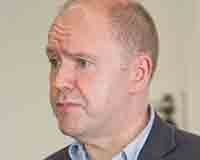 Sir Terry Farrell is a happy, albeit slightly mystified, man. He is pleased that the response to his suggestions that the definition of the central London core should be expanded to include well-connected areas presently on the fringe has been overwhelmingly positive.
Sir Terry Farrell is a happy, albeit slightly mystified, man. He is pleased that the response to his suggestions that the definition of the central London core should be expanded to include well-connected areas presently on the fringe has been overwhelmingly positive.
His London Masterplan, presented to an enthusiastic audience at MIPIM, attempts to tackle the sharp population rises expected in the capital. “There was a great deal of interest in the idea of densification,” he says. “People are coming round to realising that London isn’t full-up.”
But the Marylebone-based architect, who turns 77 next week, is slightly puzzled that those leading the charge in the provision of new space – whether it is public realm, residential or commercial – are not more ardent proponents of change in the face of their critics. He admits: “Developers have got used to being perceived as a negative force, when actually development is the way forward for opening up access to riversides and green space.”
The man who designed the MI6 Building and Embankment Place (both Thames-facing buildings) is now passionate about providing a series of bridges across the Thames in east London. “A lot of people don’t get why I’m arguing for them, but I believe that the lack of connectivity between the banks is the biggest issue holding down values there,” he explains.
Not everyone (London Forum members included) agrees that the city even needs a masterplan, but Farrell stands firm. He asks: “How can you lay out Crossrail 2 without a plan? You can’t. That doesn’t mean it should be heavy-handed as it sometimes was in the 1950s to 1970s. What I’m proposing supports evolutionary growth by lightly pinpointing a direction of travel.”
So, do members of the London Forum think that Sir Terry’s plan to move the central London boundary outwards would be good for the capital’s business? We ask four to find out.
 Ker Gilchrist head of investment, Quintain
Ker Gilchrist head of investment, Quintain
“Businesses certainly want to be located in ‘central London’ – whatever that definition is – but of growing importance is the proximity of excellent transport hubs and amenities where tomorrow’s talent can live, work and play. There will always be companies whose only goal will be to locate in a traditional, established and recognised commercial hub, but the ever-increasing demand for floorspace from occupiers competing hard for the best talent will inevitably expand the perceived boundaries – and acceptance of polycentric London locations – organically.
Can we create a further step-change in London’s economic prosperity by artificially expanding the boundary? It would make more sense to focus on further investment in transport and amenities in a range of London locations to create sustainable commercial locations with strong individual identities near which employees can live.”
 Bill Page head of business space research, Legal & General Property
Bill Page head of business space research, Legal & General Property
“Occupiers need choice at an appropriate price, but most importantly they need access to skilled labour. This can be enabled by proximity or by transportation, but is also achieved by clustering among similar sectors. Although such agglomeration can be created by masterplanning (over many years) the demand-led approach – to understand occupiers’ locational preferences, predict which areas meet these criteria and enable development accordingly – is most likely to succeed. If such initiatives spread central London to the ring road, it will be the occupier that leads this charge.”
 Dan Bayley managing director, central London offices, BNP Paribas Real Estate
Dan Bayley managing director, central London offices, BNP Paribas Real Estate
“It is hard to see how extending central London would harm business. A bigger London would mean a bigger economy and more opportunities. However, simply constructing new buildings and shops will not guarantee occupiers or success. While Chiswick Park has shown that a big development can succeed in the affluent suburbs if the scheme is big enough, the revival of Croydon is being monitored closely by potential investors and developers of outer London schemes.
In London, ‘location, location, location’ is all about accessibility and public transport nodes. The parts of London that have emerged as new business locations over the past 10 or 20 years have been accessible, principally by rail (above and below ground). It should be remembered how Canary Wharf struggled in its early years because of its poor accessibility. Before Sir Terry’s vision can become reality, the provision of public transport needs to be addressed. Crossrail 2 anyone?”
 John Dickie director of strategy and policy, London First
John Dickie director of strategy and policy, London First
“Sir Terry is right: we all need to recognise that central London is getting geographically bigger as the city’s population and economy grows. The north-south circular might not quite be the inner ring road; but Zone 2 is the new Zone 1.
And with the expansion of the centre we need policy changes to match: for example extending the congestion charging zone. Work needs to start on Crossrail 2. And we need to increase housing density within the central zone: for example through redeveloping poor post-war housing estates to deliver more, and better, homes.”










